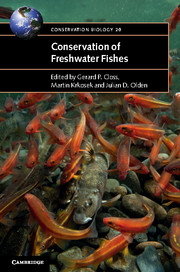Book contents
- Frontmatter
- Contents
- List of contributors
- Preface
- 1 Lost fishes, who is counting? The extent of the threat to freshwater fish biodiversity
- 2 Why are freshwater fish so threatened?
- 3 Climate change effects on freshwater fishes, conservation and management
- 4 Challenges and opportunities for fish conservation in dam-impacted waters
- 5 Chemical pollution
- 6 Multiple stressor effects on freshwater fish: a review and meta-analysis
- 7 Infectious disease and the conservation of freshwater fish
- 8 Non-indigenous fishes and their role in freshwater fish imperilment
- 9 Riparian management and the conservation of stream ecosystems and fishes
- 10 Fragmentation, connectivity and fish species persistence in freshwater ecosystems
- 11 Conservation of migratory fishes in freshwater ecosystems
- 12 Protecting apex predators
- 13 Artificial propagation of freshwater fishes: benefits and risks to recipient ecosystems from stocking, translocation and re-introduction
- 14 Freshwater conservation planning
- 15 Sustainable inland fisheries – perspectives from the recreational, commercial and subsistence sectors from around the globe
- 16 Understanding and conserving genetic diversity in a world dominated by alien introductions and native transfers: the case study of primary and peripheral freshwater fishes in southern Europe
- 17 Maintaining taxonomic skills; the decline of taxonomy – a threat to fish conservation
- 18 Synthesis – what is the future of freshwater fishes?
- Index
- References
12 - Protecting apex predators
Published online by Cambridge University Press: 05 December 2015
- Frontmatter
- Contents
- List of contributors
- Preface
- 1 Lost fishes, who is counting? The extent of the threat to freshwater fish biodiversity
- 2 Why are freshwater fish so threatened?
- 3 Climate change effects on freshwater fishes, conservation and management
- 4 Challenges and opportunities for fish conservation in dam-impacted waters
- 5 Chemical pollution
- 6 Multiple stressor effects on freshwater fish: a review and meta-analysis
- 7 Infectious disease and the conservation of freshwater fish
- 8 Non-indigenous fishes and their role in freshwater fish imperilment
- 9 Riparian management and the conservation of stream ecosystems and fishes
- 10 Fragmentation, connectivity and fish species persistence in freshwater ecosystems
- 11 Conservation of migratory fishes in freshwater ecosystems
- 12 Protecting apex predators
- 13 Artificial propagation of freshwater fishes: benefits and risks to recipient ecosystems from stocking, translocation and re-introduction
- 14 Freshwater conservation planning
- 15 Sustainable inland fisheries – perspectives from the recreational, commercial and subsistence sectors from around the globe
- 16 Understanding and conserving genetic diversity in a world dominated by alien introductions and native transfers: the case study of primary and peripheral freshwater fishes in southern Europe
- 17 Maintaining taxonomic skills; the decline of taxonomy – a threat to fish conservation
- 18 Synthesis – what is the future of freshwater fishes?
- Index
- References
Summary
INTRODUCTION
In recent years, there has arisen within the popular media a fascination with large, predatory freshwater fishes. Television shows, internet videos, blogs and magazine articles tell of adventures stalking ‘river monsters’, ‘megafish’ and ‘monster fish’. ‘Extreme fishing’ for giant freshwater fish in exotic locations has become somewhat of a fad. Even before this modern megafish fascination, large predatory fish species were icons of freshwater fish faunas. Today, many of these species also are among the most imperilled. Many features of their life histories and habitats combine to present particularly difficult management challenges (Chapter 2). This chapter presents an overview of the current understanding of the diversity, ecology and conservation status of freshwater fishes that are apex predators – fishes that occupy positions at the top of the food web. Large apex predators, arbitrarily defined here as fishes with the potential to achieve a total length of at least 1 m, tend to be strongly impacted by fisheries and other human actions.
Apex predators in freshwater ecosystems merit special attention from ecologists and conservationists for several reasons. First, they generally rank among the most valuable and heavily exploited fish stocks (Allan et al., 2005; Stone, 2007). Second, they play important roles in communities and ecosystems that can profoundly affect ecological structures and dynamics. Third, they often have life-history traits, such as migration or brood guarding, that make them highly vulnerable to impacts (Chapter 2). Given their position atop food webs, these large predators tend to have lower population densities than fishes at lower trophic levels, even within undisturbed ecosystems. Consequently, apex predators are particularly vulnerable to overexploitation and ecosystem alteration. In this regard, freshwater communities might not differ greatly from terrestrial and marine communities, and top predators oftentimes are the first species to be extirpated when humans begin to exploit renewable natural resources and to impact ecosystems (e.g. wolves in Europe and North America; lions, cheetahs and wild dogs in Africa; thylacines in Tasmania; sharks and groupers of coral reefs; sharks and billfishes in tropical oceans).
What qualifies a species to be categorised as an apex predator? The term implies that the species sits atop a trophic pyramid of population density, biomass, or energy. Some define apex predators as species having no natural enemies, but this of course is nonsense, because all species have predators, even if we exclude parasites from consideration.
- Type
- Chapter
- Information
- Conservation of Freshwater Fishes , pp. 361 - 398Publisher: Cambridge University PressPrint publication year: 2015
References
- 11
- Cited by



